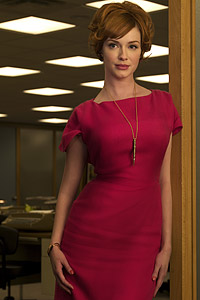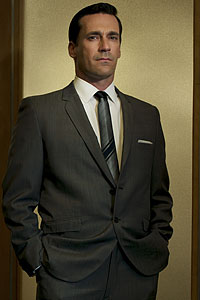 |
|||||||||||||
 I think Mad Men was probably my favorite television show last season. The show name Mad Men is derived from the ad men who worked on Madison Avenue in New York. The first season of the show revolved around the lives of people who work at a fictional ad agency called Sterling-Cooper in 1960. Despite the fictional nature of the agency depicted, the modern ad industry trade magazine Advertising Age put together a whole fictional issue with news bites, interviews, and profiles of fictional industry professionals. That is some mighty creative marketing.
I think Mad Men was probably my favorite television show last season. The show name Mad Men is derived from the ad men who worked on Madison Avenue in New York. The first season of the show revolved around the lives of people who work at a fictional ad agency called Sterling-Cooper in 1960. Despite the fictional nature of the agency depicted, the modern ad industry trade magazine Advertising Age put together a whole fictional issue with news bites, interviews, and profiles of fictional industry professionals. That is some mighty creative marketing.
Don Draper, the primary character on the show, is always quick with a clever word and a creative approach to marketing at work and coming up with the best personal presentation personally. In describing him, one of the his coworkers says, “nobody has ever turned over that rock; he could be Batman.” So his carefully-constructed persona has worked for getting his dream job and dream house and dream woman and dream family and a number of spare dream women, but the people he knows both professionally and personally sense that Don Draper is holding back to the point where he is somewhat unknowable.
Show creator Matthew Weiner also wrote a dozen episodes of The Sopranos and produced thirty-three episodes of The Sopranos, so it should come as no surprise that his baby Mad Men is about a lot of things with interlocking multiple storylines and complex and deep characterizations. It is always difficult to make a period piece come across as both convincing and relevant, but Mad Men succeeds brilliantly. In addition the the snappy dialog and strong set design, Katherine Jane Bryant’s costume design is nothing short of amazing in its variety, beauty, and attention to detail in character development. The award winning costume designer is best known for her work on another impressive period show, David Milch’s delightfully foul-mouthed HBO western Deadwood.
 On a macro level, Mad Men is about a moment in time when America, as a nation, felt optimistic and almighty but was about to feel less so. Mad Men is about a place in American history where the role of women in society was in dramatic flux and the general population’s views on bigotry over race, ethnicity, religion, and sexual orientation were all changing or about to be challenged. Many historians view the early 1960’s as when the country collectively held its breath before the tumultuous late 60’s clashed with the previously ordered world of the man in the gray flannel suit. Sort of a time when everyone was waiting for the other shoe to drop.
On a macro level, Mad Men is about a moment in time when America, as a nation, felt optimistic and almighty but was about to feel less so. Mad Men is about a place in American history where the role of women in society was in dramatic flux and the general population’s views on bigotry over race, ethnicity, religion, and sexual orientation were all changing or about to be challenged. Many historians view the early 1960’s as when the country collectively held its breath before the tumultuous late 60’s clashed with the previously ordered world of the man in the gray flannel suit. Sort of a time when everyone was waiting for the other shoe to drop.
On a micro level, Mad Men is about the ways in which human relationships make us vulnerable, force us to expose ourselves, and create strife when we want a little extra privacy. On the surface, a number of the characters look like they have perfect lives, but they all struggle to keep what they have built together. Whenever the characters in Mad Men feel envy of one another, the viewer cringes, knowing what discomfort is behind those facades. This will resonate if you have ever gone to a corporate office job and done your best to make the right impression, all the while worried that somehow people can tell that you have to make the effort to come across like they do naturally.
While pitching Kodak at Sterling-Cooper, Don Draper explains that, in Greek, nostalgia means the pain from an old wound. According to the Advertising Age, err, articles, Sterling-Cooper got the account for the Kodak slide carousel after Don Draper said, “This device isn’t a spaceship, it’s a time machine. It goes backwards, and forwards. It takes us to a place where we ache to go again. It’s not called the wheel; it’s called the carousel. It let’s us travel the way a child travels around and around, and back home again. To a place where we know are loved.” This pitch is from a man who has erased his early personal history and has no one left to share most memories with.
The two most common responses Mad Men evokes are laughter and a certain deep ache sort of pain. It is not entirely a feelgood series, but it is aesthetically lovely, verbally witty, and emotionally moving. New season starts tonight with a dateline of 1962, two years after season one ended. I hope season two can live up to the high expectations set by season one.
The conventional wisdom is that more people were forced to present a false front to the world in the early 1960’s than now. I’m not sure whether that is reality or wishful thinking, but I’m looking forward to season two of a show which makes me think about important questions like that.
Shortlink: